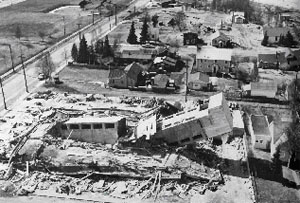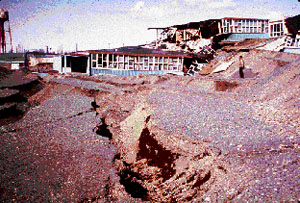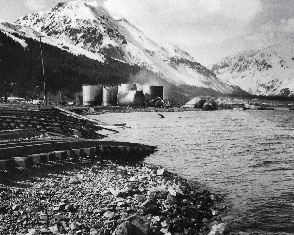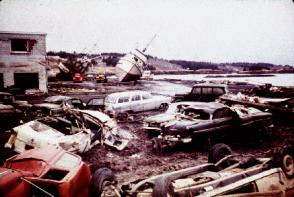The response of the U.S. Army Corps of Engineers to the Alaskan earthquake of 1964 was prompt and positive. On Good Friday afternoon, 27 March, a violent earthquake rocked 50,000 square miles of south-central Alaska. The intensity of the shock measured between 8.4 and 8.6 on the Richter scale, releasing twice as much energy as the quake that destroyed San Francisco in 1906. Only the low density of the state's population, and the hour—5:35 p.m., when schools were empty, business areas uncrowded, and tides low—prevented the death toll from exceeding 114. Property damage totaled more than $500 million. In downtown Anchorage the upheaval leveled the unfinished Four Seasons apartment building and two parking garages. An elementary school and several homes slid into Ship Creek Valley, settling on top of an Alaska Railroad warehouse. Businesses on three blocks of 4th Avenue sank 10 to 20 feet into the earth.
 |
 |
Former six-story Four Seasons apartment building (left);
and Government Hill elementary school (right)
At nearby Seward, which was preparing to celebrate its selection as an "All-American city," floods destroyed the industrial areas and the port, including the southern terminus of the Alaska Railroad. Tidal waves also obliterated other ports along Alaska's southern coasts. At Kodiak, a wave lifted the crab fishing fleet out of the harbor and carried boats through the town. Canneries on the waterfront disappeared.
The Corps of Engineers, in association with the Office of Emergency Planning (FEMA's predecessor), moved quickly to help communities in distress. Though many of their homes were in ruins, employees of the Corps' Alaska District reported for duty immediately. Less than 10 hours after the calamity, Alaska District Engineer Colonel Kenneth T. Sawyer sent emergency teams in light aircraft to assess the damage. Within the next few days Colonel Sawyer established special project offices at Anchorage, Valdez, and Seward to administer contracts for debris clearance, demolition, and repairs to sewers, water supplies, communications, and power distribution systems. Chief of Engineers Lt. Gen. Walter K. Wilson Jr. organized an emergency disaster team of 65 engineers from the Walla Walla, Seattle, and Portland districts to assist in the rebuilding program. Retired Engineer Brig. Gen. Benjamin B. Talley, who had experience in military construction in Alaska during World War II, did much of the restoration design as a contractor with a private engineering firm.
 |
 |
Seward waterfront and railroad damage (left);
and tsunami damage along the waterfront at Kodiak (right)
The first priorities were reopening highways and re-establishing essential water and fuel supplies. Toward these goals, the Alaska District let contracts quickly. Merely clearing roadways was an enormous task. As one bulldozer operator reported, "It took us twelve hours to cut through the biggest slide, and when we got through there was another just ahead." In Anchorage alone, reconstruction expenditures averaged $1 million a month for the first year after the disaster. Racing against the calendar, the Corps managed to complete most important repairs before the Alaskan winter arrived. In addition, the Alaska District channeled most of the restoration work to hard-hit local businesses, providing employment to residents whose livelihoods had been disrupted.
Altogether the Corps spent more than $110 million on salvage, rescue, and rehabilitation operations in Alaska. Once again the Corps had moved quickly and efficiently to assist people in desperate circumstances. To the earthquake victims the code name for the relief effort, "Operation Helping Hand," seemed apt.
Photograph sources:
Earth Science Photographs from the U.S. Geological Survey Library, U.S. Geological Survey, and NOAA/NGDC.
Engineering in the Far North - A History of the U.S. Army Engineer District in Alaska (1867-1992), Lisa Mighetto and Carla Homstad, 1997.
For more on the Corps of Engineers' emergency operations mission, see the Office of History publications Situation Desperate (Origins to 1950) and Destruction Imminent (1950 to 1979).
* * *
March 2002. No. 47.